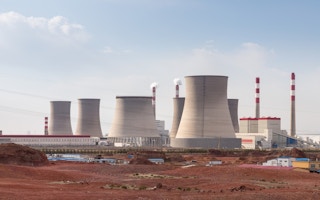Asian financial institutions are the world’s biggest funders and insurers of the coal industry, and have increased their support for the sector over the last few years, a report from civic society groups has shown.
To continue reading, subscribe to Eco‑Business.
There's something for everyone. We offer a range of subscription plans.
- Access our stories and receive our Insights Weekly newsletter with the free EB Member plan.
- Unlock unlimited access to our content and archive with EB Circle.
- Publish your content with EB Premium.
Asia accounts for almost 80 per cent of the world’s coal consumption. The region’s banks were responsible for 61 per cent of coal lending and underwriting in 2019. That proportion increased to 66 per cent in 2020, the report from Urgewald, Reclaim Finance, and 350.org found.
Globally, banks’ lending and underwriting for the coal industry amounted to US$456 billion in the first 10 months of 2020; US$ 3 billion more than during the same period in 2019, even though energy demand slumped amid the Covid-19 pandemic.
Japanese banks were the biggest lenders globally, providing US$75 billion in loans to the coal industry between October 2018 and October 2020.
Mizuho, Mitsubishi UFJ Financial Group and Sumitomo Mitsui Banking Corporation (SMBC) were the biggest three lenders, with SMBC increasing its coal lending by 81 per cent from 2016, the year after the signing of the Paris climate accord.
All three banks have made public commitments to reduce their coal exposure in recent years, but these policies are among the weakest in the world, said Eri Watanabe, a climate campaigner for 350.org Japan. “They only cover a small portion of banks’ lending and do not rule out corporate loans or underwriting for companies that are still building new coal plants in Japan, Vietnam, the Philippines and elsewhere.”
Japan, China, and India together account for 70 per cent of global underwriting to coal companies, with China — where more than half of the world’s coal is burned — the biggest underwriter. The country underwrote 58 per cent of coal projects launched over the past two years and channelled US$467 billion in corporate loans and project finance to the coal industry over the same time period.
The single biggest coal backer is the Industrial and Commercial Bank of China (ICBC). Its support for coal dipped in 2017 and 2018, but rose beyond its 2016 total lending and underwriting (US$13.98 billion) to US$18.38 billion in 2019. From January to October 2020, its financial support for coal was US$18.22 billion.
As for institutional investors, the United States is by far the biggest backer of coal, accounting for 58 per cent of institutional investment worth US$602 billion in the coal trade. Japan and the United Kingdom are the second and third biggest institutional investors in coal.
It is India and China that feel the biggest health impact of burning coal. A new study by researchers at Harvard University, University College London, and the University of Birmingham found that the two countries alone account for 60 per cent of deaths from air pollution caused by the burning of fossil fuels, which include oil and natural gas as well as coal, worldwide.
The study found that in 2018, 8.7 million deaths globally were associated with breathing polluted air, almost one fifth of all deaths worldwide. Coal is the dirtiest of fossil fuels, and the single biggest contributer to human-caused climate change.








